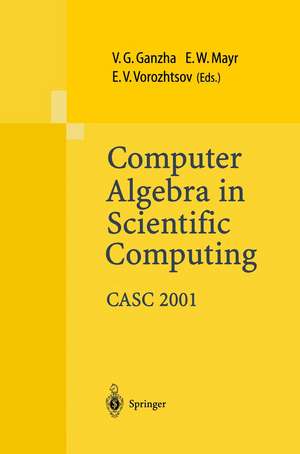Computer Algebra in Scientific Computing CASC 2001: Proceedings of the Fourth International Workshop on Computer Algebra in Scientific Computing, Konstanz, Sept. 22-26, 2001
Editat de Viktor G. Ganzha, Ernst W. Mayr, Evgenii V. Vorozhtsoven Limba Engleză Paperback – 27 oct 2012
Preț: 403.91 lei
Nou
Puncte Express: 606
Preț estimativ în valută:
77.29€ • 81.07$ • 64.34£
77.29€ • 81.07$ • 64.34£
Carte tipărită la comandă
Livrare economică 01-15 aprilie
Preluare comenzi: 021 569.72.76
Specificații
ISBN-13: 9783642626845
ISBN-10: 364262684X
Pagini: 572
Ilustrații: XI, 555 p.
Dimensiuni: 155 x 235 x 30 mm
Greutate: 0.79 kg
Ediția:Softcover reprint of the original 1st ed. 2001
Editura: Springer Berlin, Heidelberg
Colecția Springer
Locul publicării:Berlin, Heidelberg, Germany
ISBN-10: 364262684X
Pagini: 572
Ilustrații: XI, 555 p.
Dimensiuni: 155 x 235 x 30 mm
Greutate: 0.79 kg
Ediția:Softcover reprint of the original 1st ed. 2001
Editura: Springer Berlin, Heidelberg
Colecția Springer
Locul publicării:Berlin, Heidelberg, Germany
Public țintă
ResearchDescriere
CASC 2001 continues a tradition ~ started in 1998 ~ of international con ferences on the latest advances in the application of computer algebra systems to the solution of various problems in scientific computing. The three ear (CASs) lier conferences in this sequence, CASC'98, CASC'99, and CASC 2000, were held, Petersburg, Russia, in Munich, Germany, and in Samarkand, respectively, in St. Uzbekistan, and proved to be very successful. We have to thank the program committee, listed overleaf, for a tremendous job in soliciting and providing reviews for the submitted papers. There were more than three reviews per submission on average. The result of this job is reflected in the present volume, which contains revised versions of the accepted papers. The collection of papers included in the proceedings covers various topics of computer algebra methods, algorithms and software applied to scientific computing. In particular, five papers are devoted to the implementation of the analysis of involutive systems with the aid of CASso The specific examples include new efficient algorithms for the computation of Janet bases for monomial ideals, involutive division, involutive reduction method, etc. A number of papers deal with application of CASs for obtaining and vali dating new exact solutions to initial and boundary value problems for partial differential equations in mathematical physics. Several papers show how CASs can be used to obtain analytic solutions of initial and boundary value problems for ordinary differential equations and for studying their properties.
Cuprins
Jets. A Maple-Package for Formal Differential Geometry.- Computing Stratifications of Quotients of Finite Groups and an Application to Shape Memory Alloy.- A MuPAD Library for Differential Equation.- Algebraic Identification Algorithm and Application to Dynamical Systems.- Cooperation Between a Dynamic Geometry Environment and a Computer Algebra System for Geometric Discovery.- On the Stability of Steady Motions of a Solar-Sail Satellite.- Application of Computer Algebra for Investigation of a Group Properties of the Navier-Stokes Equations for Compressible Viscous Heat-Conducting Gas.- Mathematica and Nilpotent Lie Superalgebras.- Neighborhoods of an Ordinary Linear Differential Equation.- Invariants of Finite Groups and Involutive Division.- Symbolic Computation and Boundary Conditions for the Wave Equation.- Parametric Systems of Linear Congruences.- Bifurcation Analysis of Low Resonant Case of the Generalized Henon - Heiles System.- An Involutive Reduction Method to Find Invariant Solutions for Partial Differential Equations.- Recurrence Functions and Numerical Characteristics of Graphs.- A New Combinatorial Algorithm for Large Markov Chains.- GROOME - Tool Supported Graphical Object Oriented Modelling for Computer Algebra and Scientific Computing.- Construction of Janet Bases I.Monomial Bases.- Construction of Janet Bases II.Polynomial Bases.- Low-Dimensional Quasi-Filiform Lie Algebras with Great Length.- Algebraic Methods for Sectioning Parametric Surfaces.- The Methods of Computer Algebra and the Arnold-Moser Theorem.- Symbolic Algorithms of Algebraic Perturbation Theory: Hydrogen Atom in the Field of Distant Charge.- Perturbation versus Differentiation Indices.- Employment of the Gröbner Bases in Analysis of Systems Having Algebraic First Integrals.- “Coalgebra” Structures on 1-Homological Models for Commutative Differential Graded Algebras.- Conservative Finite Difference Schemes for Cosymmetric Systems.- A Mathematica Solver for Two-Point Singularly-Perturbed Boundary Value Problems.- A New Algorithm for Computing Cohomologies of Lie Superalgebras.- Parallel Computing with Mathematica.- Solution of Systems of Linear Diophantine Equations.- SYMOPT: Symbolic Parametric Mathematical Programming.- Representing Graph Properties by Polynomial Ideals.- Parametric G1-Blending of Several Surfaces.- A Method of Logic Deduction and Verification in KBS Using Positive Integers.- Progressive Long Waves on a Slope (A New Solution to the Euler Equation?).- The Method of Newton Polyhedra for Investigating Singular Positions of Some Mechanisms.- Algebraic Predicates for Empirical Data.- Fractional Driftless Fokker-Planck Equation with Power Law Diffusion Coefficients.- Factorization of Overdetermined Systems of Linear Partial Differential Equations with Finite-Dimensional Solution Space.- Semilinear Motion Planning Among Moving Objects in REDLOG.- Author Index.
Textul de pe ultima copertă
The book covers various topics of computer algebra methods, algorithms and software applied to scientific computing. An important topic presented in the book, which may be of interest to researchers and engineers, is the application of computer algebra methods to the development of new efficient analytic and numerical solvers, both for ordinary and partial differential equations. A specific feature of the book is an intense use of advanced software systems like Mathematica, Maple etc. for the solution of problems as outlined above and for the industrial application of computer algebra for simulation. The book will be useful for researchers and engineers who apply advanced computer algebra methods for the solution of their problems.
Caracteristici
Includes supplementary material: sn.pub/extras














